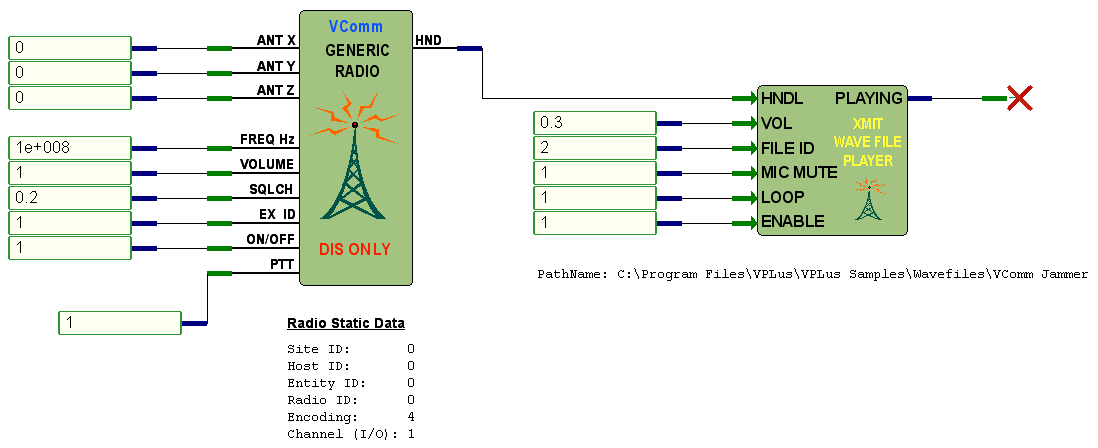|
|
VComm Radio Transmitter Wave File Player |
|
ID: 2057 |
|
|
VComm Radio Transmitter Wave File Player |
|
ID: 2057 |
|
Object Description |
|
|
The VComm Radio Transmitter Wave File Player object can be used in conjunction with VComm Radio Objects to generate a waveform from a wave file and stream it through the radio's network transmission. The normal microphone audio stream can be muted or mixed with the generated waveform. Most audio effects that are added to the radio stream to simulate an effect, such as jamming and test tones, are added to the receive side of the audio stream. The DIS protocol specifies that all effects are to be added at the receiver, and all transmitters send their audio without any effects to improve interoperability. In some cases, however, it may be necessary to send the waveform effect out to the networked audio stream (e.g., jamming, HAVEQUICK MICKEY synch, etc.).
To use the object, connect the radio handle output of a radio/intercom object to the radio handle input of this object. The data that is present on the input pins is sent to the radio object and overrides the Networked Audio configuration values. |
|
|
Special Notes |
|
|
|
|
Input Pins |
|
|
HNDL |
The HNDL pin accepts a Radio Handle from either the VComm GENERIC Radio, V8 DIS Only, VComm GENERIC Radio, V8 DIS/HLA, or VComm Simple Intercom objects. |
|
VOL |
The VOLume pin sets the audio output level for this object. The valid range of this parameter is 0.0 (no volume) to 1.0 (full volume). |
|
FILE ID |
The FILE ID pin can be any positive integer. It is part of the composite filename as defined in the Special Notes above. A value of 0 is the same as setting the ENABLE pin to 0. |
|
MIC MUTE |
The MIC MUTE pin controls whether the microphone is muted while this object is enabled. Any non-zero value will mute the microphone. A value of 0 allows microphone input to the audio stream. |
|
LOOP |
This LOOP pin will enable looping with any non-zero value. If the pin is 0, the wave file will play once and stop. This pin is sampled only during the time that the ENABLE pin transitions from zero to one. Changing the value has no effect once the player has started. |
|
ENABLE |
The ENABLE pin is used to turn the object on or off. The player is activated with any non-zero value. If the object is playing, returning this pin to zero will stop the player.
|
|
Output Pin |
|
|
PLAYING |
The PLAYING pin produces a 1 when a wave file is playing and a 0 otherwise. It will continue playing even if the radio's PTT has been disabled. |
|
Static Data |
|
|
PathName |
This is a string which represents the path and partial filename of the wave file to be played. Note that a partial filename must be provided. |
|
Example |
|
|
In this example, A DIS Only radio has a VComm Radio Transmitter Wave File Player object attached to it. The radio is transmitting with the microphone muted. The player is enabled and will loop the wave file at a volume of 0.2. The name of the file being played is C:\Program Files\VPLus\VPLus Sample\Wavefiles\VComm Jammer 2.wav. Note: Three other wave file examples are provided in the C:\Program Files\VPLus\VPLus Sample\Wavefiles\ folder:
|
|
